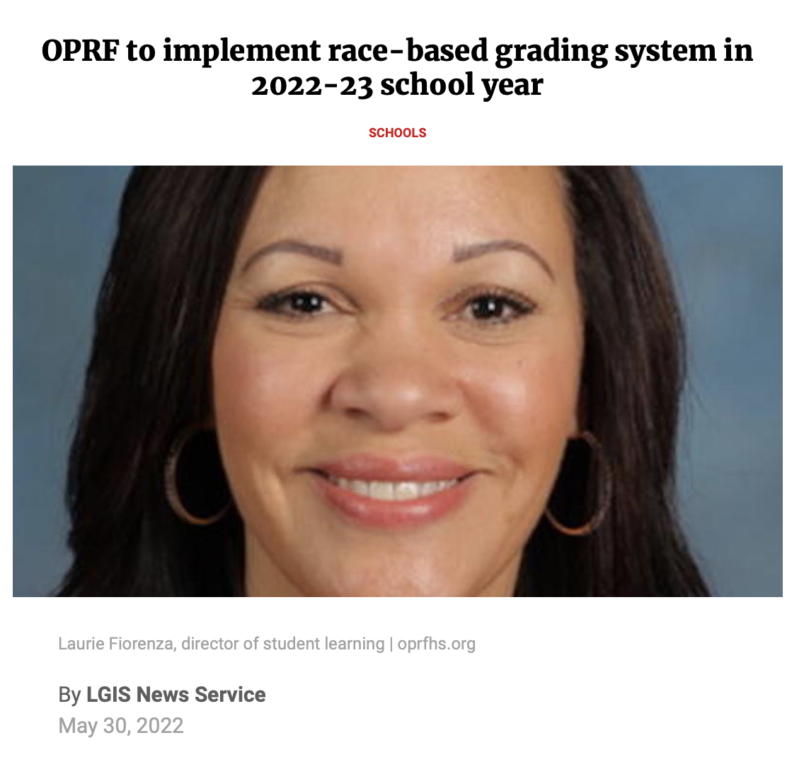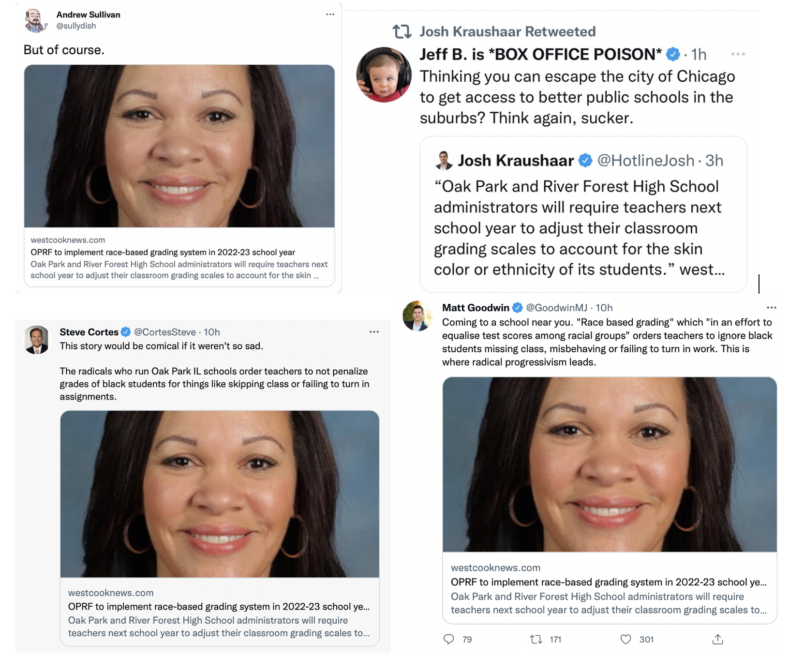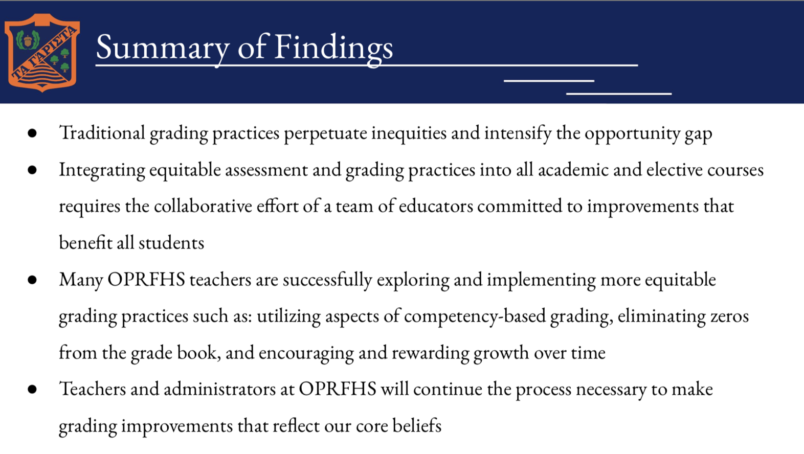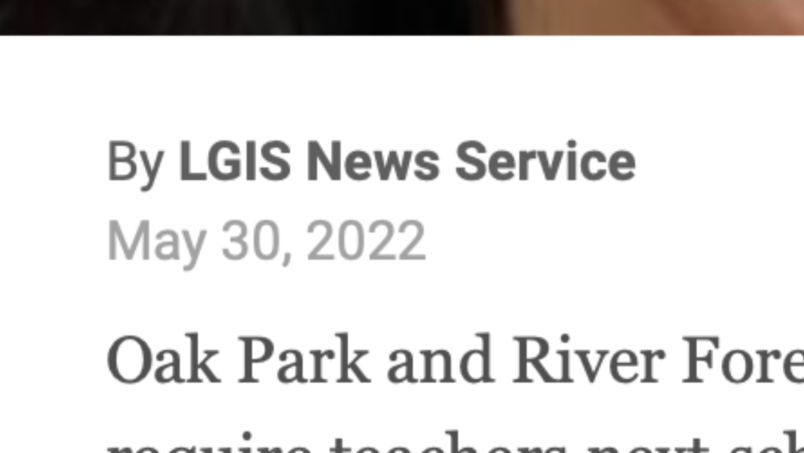This article is part of TPM Cafe, TPM’s home for opinion and news analysis. It first appeared on the Substack blog Can We Still Govern?
This is the tale of a fake news story, widely shared by a lot of smart people who so badly wanted it to be true that they didn’t care that it wasn’t. It is also the tale of the decline of local news in America, the wave of pink slime that is replacing it, feeding destructive partisan narratives about public institutions.
Here is the headline (and the image) of the viral story. 1

And here is the lede:
Oak Park and River Forest High School administrators will require teachers next school year to adjust their classroom grading scales to account for the skin color or ethnicity of its students. In an effort to equalize test scores among racial groups, OPRF will order its teachers to exclude from their grading assessments variables it says disproportionally hurt the grades of black students. They can no longer be docked for missing class, misbehaving in school or failing to turn in their assignments, according to the plan.
This sounds bad! A Chicago suburban school is handing out different grades depending on race! You can’t punish students for misbehaving!
Nor surprisingly, people were outraged. The story went viral, with big Twitter names posting it to their hundreds of thousands of followers. (Some would later delete their tweet for reasons that will become clear below.)

The school released a statement, which included the following:
It has come to the District’s attention that a recent article in the online West Cook News inaccurately states that at the Board of Education’s May 26 meeting, Oak Park and River Forest High School announced that it will implement a race-based grading system in the 2022-2023 school year. This is not true.
OPRFHS does not, nor has it ever had a plan to, grade any students differently based on race. The article contains a variety of misleading and inaccurate statements. The article’s mischaracterization of the Board meeting is unfortunate and has caused unnecessary confusion.
As part of the Board of Education’s strategic plan, the OPRFHS Grading and Assessment Committee was formed to examine national research on objective, unbiased practices for determining whether students have mastered academic content. At the Board of Education’s May 26 meeting, the administration’s representative to the OPRFHS Grading and Assessment Committee provided an initial report that included a progress update on the committee’s examination of grading practices.
At no time were any statements made recommending that OPRF implement a race-based grading approach.
In other words, no new policies had been adopted. A committee on grading and assessment provided an initial report. There is no race-based grading or plans to grade students using different standards according to race. (As Michael Hobbes has pointed out elsewhere, moral panic journalism frequently makes its claims based on draft or obscure documents rather than actual policies, because the actual policies are harder to mischaracterize.)
One of these accounts is clearly inaccurate. Unfortunately, it is the one that went viral.
Let’s dig in a bit more. The only direct evidence the report provided about the proposed policy change was a PowerPoint deck presented at at a May 26 school board meeting. This is the most damning slide, which the piece quoted.

Nowhere in the PowerPoint slide or elsewhere in the article is there material that supports the claim laid out in the lede that a) policy change has taken place, and b) students “can no longer be docked for missing class, misbehaving in school or failing to turn in their assignments.”
Thus the piece has failed the most basic journalistic standard: it has not provided evidence either for the sensationalistic headline or its core claims.
Well, what does the reporter have to say about this? Huh, no byline beyond the mysterious LGIS News Service.

What is the LGIS News Service you ask? The answer reveals much more about our media environment, and is even more disturbing than the botched story suggests.
Awash in pink slime
Local Government Information Services is the publisher of lots of local news media in Illinois, with titles like “Southern Illinois News” and “SW Illinois news.” LGIS is part of a much larger network of local news in multiple states. As local news media has disappeared “pink slime” outlets like LGIS have taken their place, relying on low-cost or automated content repeated across sites, and eschewing basic journalistic practices.
Just how big and how connected these local news outlets are is difficult to discern. In 2020, the New York Times counted about 1,200 connected local news outlets that had arisen in just 10 years.

Behind this empire of pink slime is Brian Timpone, a conservative businessman and former journalist with a record of plagiarism and fabrication. It is not just that his media has an ideological outlook, or that it frequently uses deceptive practices such as the story detailed here. They are also directly funded by conservative advocates, a fact that is rarely disclosed to readers. At least $1.7 million could be traced going from Republican campaigns to Timpone’s companies, but the actual number is unknown given the shadowy nature of the flow of political money and the obtuse structure of these networks.
The New York Times documented how this works. A freelance reporter took $22 to write a critical piece about an opponent of Susan Collins, to be published in the Maine Business Daily. The article featured quotes from Collins campaign under the headline “Sen. Collins camp says House Speaker Gideon’s actions are hypocritical” but did not contact the subject of the story. The client funding the story was a Republican operative.
In other words, a partisan operative can, for a fee, use dark money to get another partisan operative to publish campaign materials masquerading as local news. Freelancers, many of whom don’t live in the U.S., let alone the locality they are supposed to be covering, are paid a pittance, directed who to interview and what to write, often by the clients, who are sometimes the subject of flattering coverage. One sales pitch to such clients offered “a $2,000 package that included running five articles and unlimited news releases. The salesman stressed that reporters would call the shots on some articles, while the client would have a say on others.” In some cases, the clients simply provide the content directly. One GOP candidate paid Timpone’s companies $55,000 over three years, and received consistent and positive coverage from the Timpone’s Illinois media outlets, including the publication of verbatim press releases.
Motivated reasoning and fake news
The viral story comes from an ecosystem of paid partisan news. We don’t know if the story was ordered by an advocate, or their agenda. Much of the time such news does not reach the virality achieved here (and associated scrutiny) to have an impact at a local level where there are few if any competing resources.
So why should intelligent people share a sensationalistic headline story from an unfamiliar source, with some pretty large gaps if they cared to look closely at the details?
Blame it on motivated reasoning, a form of confirmation bias that makes us more critical of information that runs contrary to our ideological beliefs, but more credulous of information that aligns with those beliefs. In my own research I’ve pointed to the ways that motivated reasoning causes policymakers both to make decision-making errors and then double down when challenged.
Other researchers have looked specifically at how motivated reasoning relates to the sharing of fake news. They examined the behavior of 2,300 actual Twitter users. The most frequent sharers of fake news were not ignorant, but highly polarized.
Thus, individuals who report hating their political opponents are the most likely to share political fake news and selectively share content that is useful for derogating these opponents. Overall, our findings show that fake news sharing is fueled by the same psychological motivations that drive other forms of partisan behavior, including sharing partisan news from traditional and credible news sources.
Maybe we were always like that or maybe things have gotten worse. But what this story illustrates is that the supply of false stories designed to feed motivated reasoning has become worse, at least on the right. Local journalists with a sense of responsibility to journalistic ethics, their personal reputation, and the community they live in have been replaced by anonymous for-hire freelancers paid crumbs to feed the motivated reasoning beast.
To be clear, it’s perfectly reasonable to debate the effects of educational practices. But they should be actual educational practices. As I’ve noted elsewhere, so much of contemporary education debate and policymaking is based on unrepresentative examples and moral panics that needlessly denigrate and censor teachers.
People want to believe these sorts of stories are not just true, but typical. “But of course,” they type, and retweet. Even after they have been corrected, they might think to themselves, “Well, maybe this specific piece was exaggerated, but it is representative of a broader trend.”
The episode is indeed representative and telling, but of something that has gone wrong in our media landscape. When you give the benefit of the doubt to partisan fake news rather than professional educators, it is hard to take the whole “I’m here to defend education” bit too seriously. Our looming crisis in education is not runaway wokeness, which local school boards can police, but the willingness of those who should know better to reflexively denigrate the teaching profession.
1 Readers can judge for themselves if framing “race based grading” under the name and picture of a female educator of color is a deliberate choice or not. That said, I would not like to see what Ms. Fiorenza’s inbox looks like after this story.
If you found this post useful, please check out the archive, consider subscribing if you have not done so, and share with others! Hat tip to @RhiannonDauster and @deonteleologist whose original tweets made me look into this story.
Donald Moynihan is a professor at the McCourt School of Public Policy at Georgetown University, and author of the blog Can We Still Govern?







And of course Andrew Sullivan fell for it.
Very important story. It would be great if it were widely read. Not holding my breath, however.
I Googled “andrew sullivan asshole”.
The results were beyond counting.
What it tells us is that they’re so starved for cash that getting a click matters more than having a reputation.
Adjusted for accuracy…